Abstract
In the genus Klebsiella, the growth respnse in nutient broth at 10 degrees C correlates inversely with the operational definition of a fecal coliform and not merely with the ability to grow at 44.5 degrees C. Of the fecal coliform-positive Klebsiella, 97% did not grow at 10 degrees C after 72 h of incubation. Conversely, 97% of the fecal coliform-negative isolates grew at 10 degrees C. The amount of growth at 10 degrees C varied among the fecal coliform-negative isolates and was found to correlate with indole production and pectin liquefaction. Low-temperature growth associated with specific biochemical tests can be used to differentiate several groups in the genus Klebsiella. Three main groups were discerned. Group I consists of indole-negative, pectin-nonliquefying, fecal coliform-positive isolates that do not grow at 10 degrees C. Group II isolates are differentiated from group I by a fecal-coliform-negative response and growth at 10 degrees C. Group III are indole-positive, pectin-liquefying, fecal coliform-negative isolates that grow at 10 degrees C. In our culture collection, isolates of group I are most frequently of human/animal clinical origins, whereas isolates of groups II and III are predominantly derived from the environment.
Full text
PDF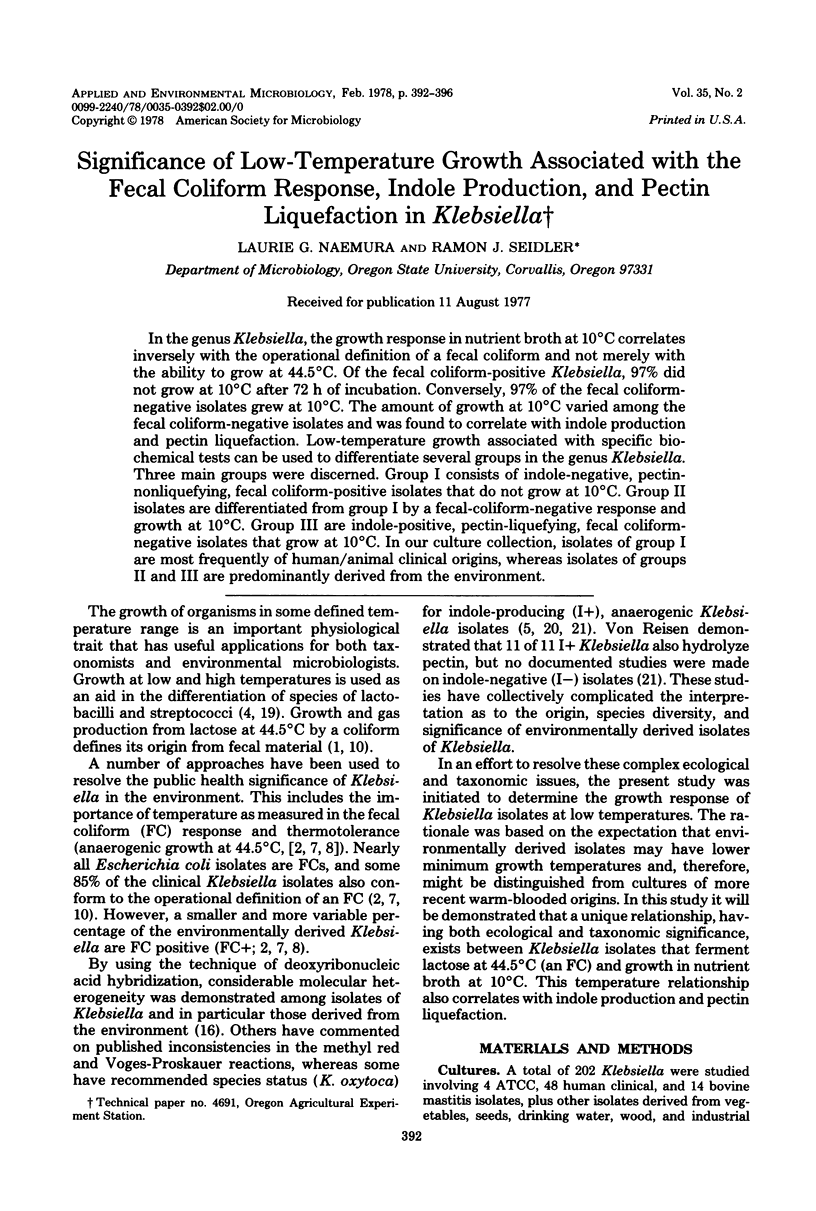
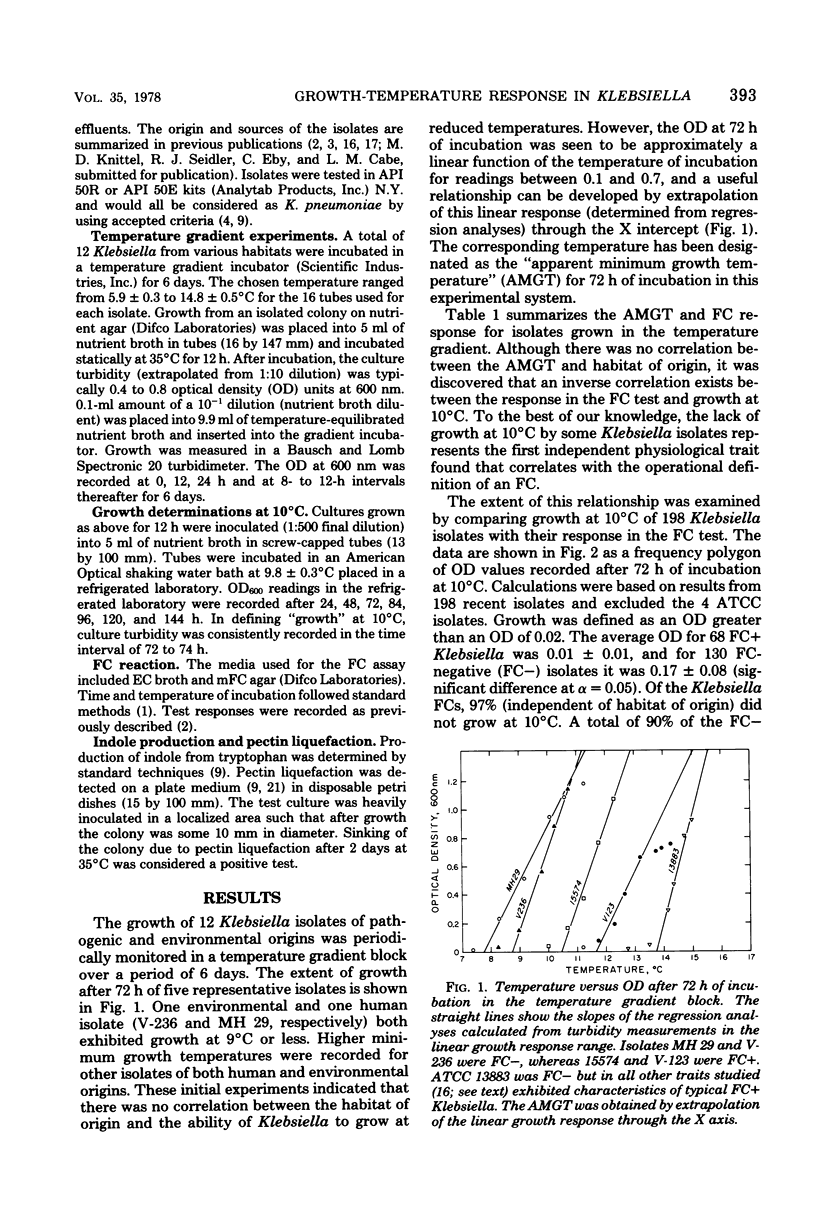
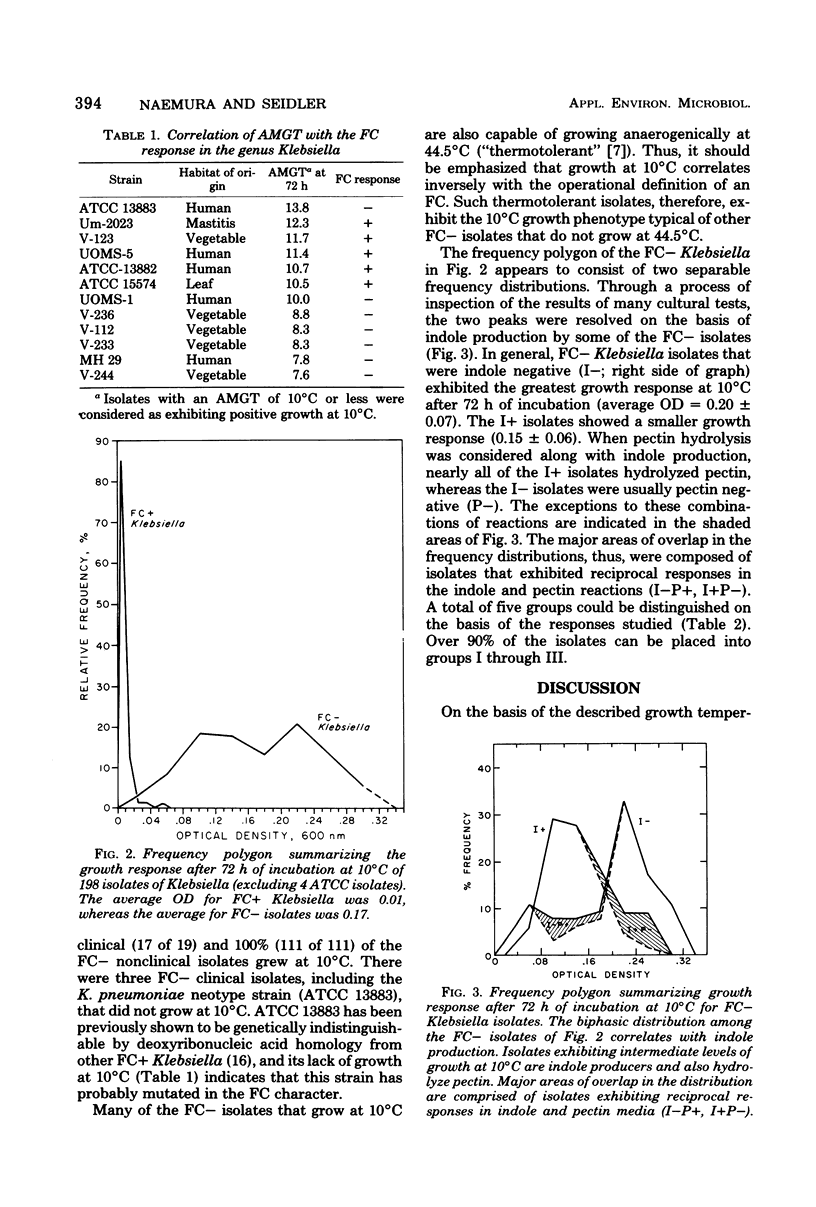
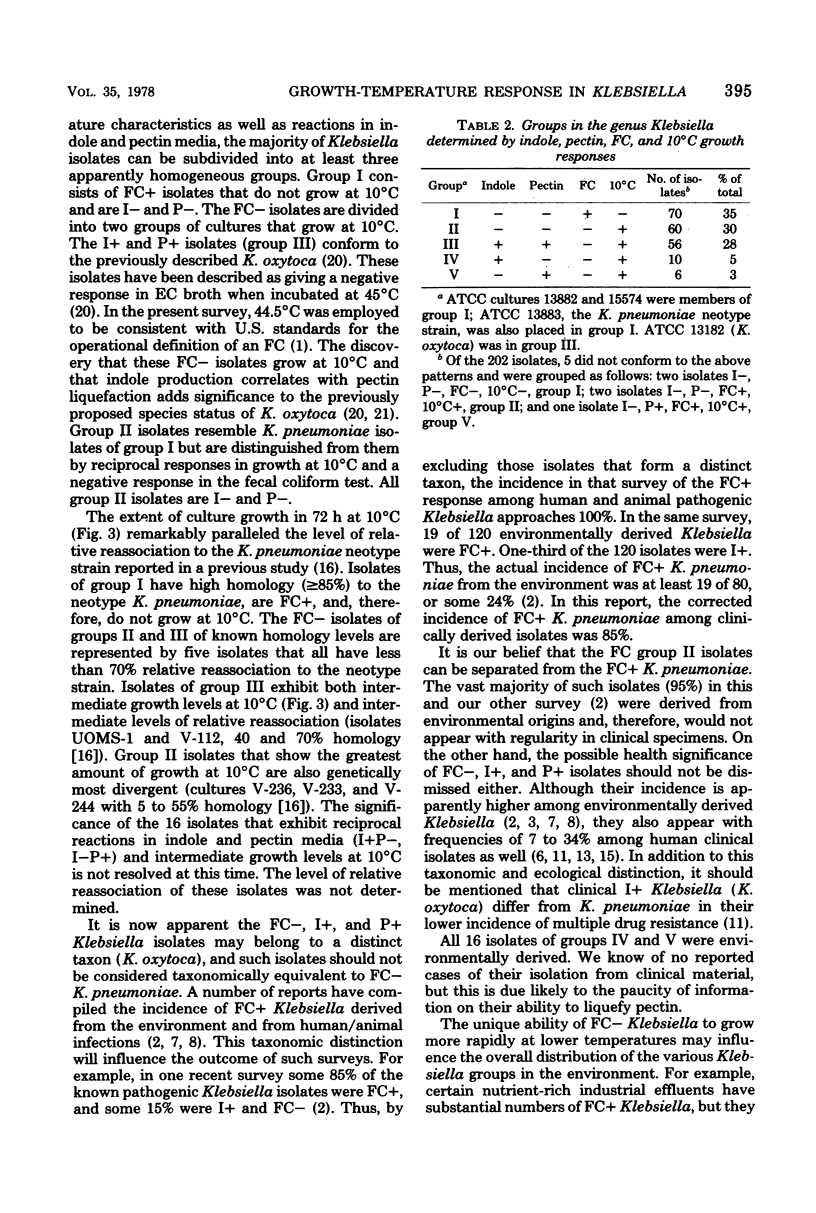
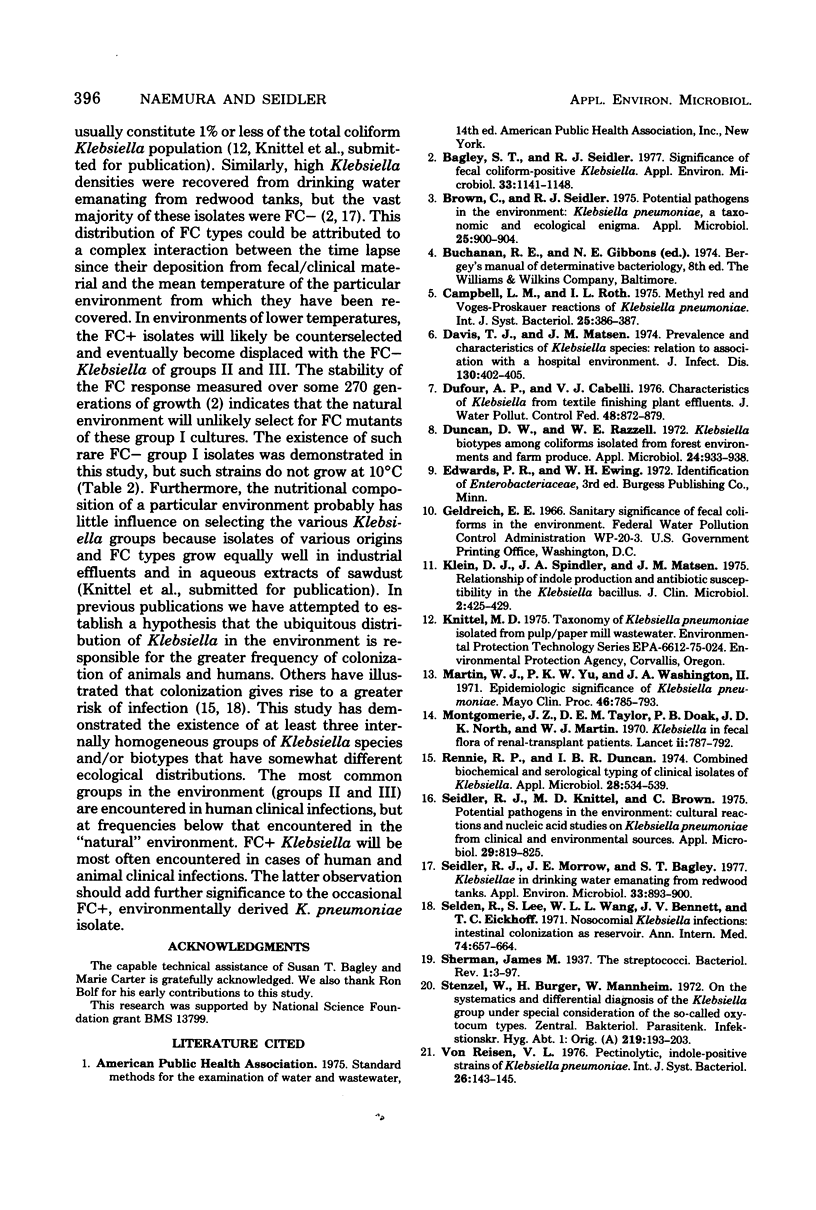
Selected References
These references are in PubMed. This may not be the complete list of references from this article.
- Bagley S. T., Seidler R. J. Significance of fecal coliform-positive Klebsiella. Appl Environ Microbiol. 1977 May;33(5):1141–1148. doi: 10.1128/aem.33.5.1141-1148.1977. [DOI] [PMC free article] [PubMed] [Google Scholar]
- Brown C., Seidler R. J. Potential pathogens in the environment: Klebsiella pneumoniae, a taxonomic and ecological enigma. Appl Microbiol. 1973 Jun;25(6):900–904. doi: 10.1128/am.25.6.900-904.1973. [DOI] [PMC free article] [PubMed] [Google Scholar]
- Davis T. J., Matsen J. M. Prevalence and characteristics of Klebsiella species: relation to association with a hospital environment. J Infect Dis. 1974 Oct;130(4):402–405. doi: 10.1093/infdis/130.4.402. [DOI] [PubMed] [Google Scholar]
- Dufour A. P., Cabelli V. J. Charateristics of Klebsiella from textile finishing plant effluents. J Water Pollut Control Fed. 1976 May;48(5):872–879. [PubMed] [Google Scholar]
- Duncan D. W., Razzell W. E. Klebsiella biotypes among coliforms isolated from forest environments and farm produce. Appl Microbiol. 1972 Dec;24(6):933–938. doi: 10.1128/am.24.6.933-938.1972. [DOI] [PMC free article] [PubMed] [Google Scholar]
- Klein D., Spindler J. A., Matsen J. M. Relationship of indole production and antibiotic susceptibility in the Klebsiella bacillus. J Clin Microbiol. 1975 Nov;2(5):425–429. doi: 10.1128/jcm.2.5.425-429.1975. [DOI] [PMC free article] [PubMed] [Google Scholar]
- Martin W. J., Yu P. K., Washington J. A., 2nd Epidemiologic significance of Klebsiella pneumoniae. A 3-month study. Mayo Clin Proc. 1971 Dec;46(12):785–793. [PubMed] [Google Scholar]
- Montgomerie J. Z., Doak P. B., Taylor D. E., North J. D., Martin W. J. Klebsiella in faecal flora of renal-transplant patients. Lancet. 1970 Oct 17;2(7677):787–792. doi: 10.1016/s0140-6736(70)91458-3. [DOI] [PubMed] [Google Scholar]
- Rennie R. P., Duncan I. B. Combined biochemical and serological typing of clinical isolates of Klebsiella. Appl Microbiol. 1974 Oct;28(4):534–539. doi: 10.1128/am.28.4.534-539.1974. [DOI] [PMC free article] [PubMed] [Google Scholar]
- Seidler R. J., Knittel M. D., Brown C. Potential pathogens in the environment: cultural reactions and nucleic acid studies on Klebsiella pneumoniae from clinical and environmental sources. Appl Microbiol. 1975 Jun;29(6):819–825. doi: 10.1128/am.29.6.819-825.1975. [DOI] [PMC free article] [PubMed] [Google Scholar]
- Seidler R. J., Morrow J. E., Bagley S. T. Klebsielleae in drinking water emanating from redwood tanks. Appl Environ Microbiol. 1977 Apr;33(4):893–900. doi: 10.1128/aem.33.4.893-900.1977. [DOI] [PMC free article] [PubMed] [Google Scholar]
- Selden R., Lee S., Wang W. L., Bennett J. V., Eickhoff T. C. Nosocomial klebsiella infections: intestinal colonization as a reservoir. Ann Intern Med. 1971 May;74(5):657–664. doi: 10.7326/0003-4819-74-5-657. [DOI] [PubMed] [Google Scholar]
- Sherman J. M. THE STREPTOCOCCI. Bacteriol Rev. 1937 Dec;1(1):3–97. doi: 10.1128/br.1.1.3-97.1937. [DOI] [PMC free article] [PubMed] [Google Scholar]


